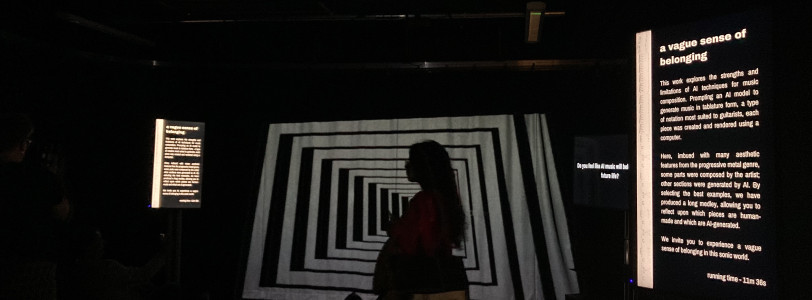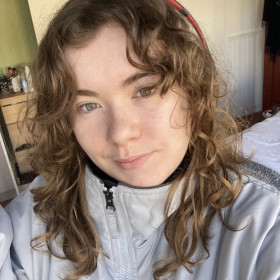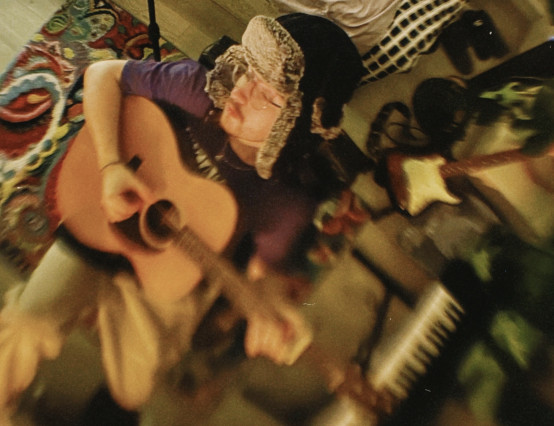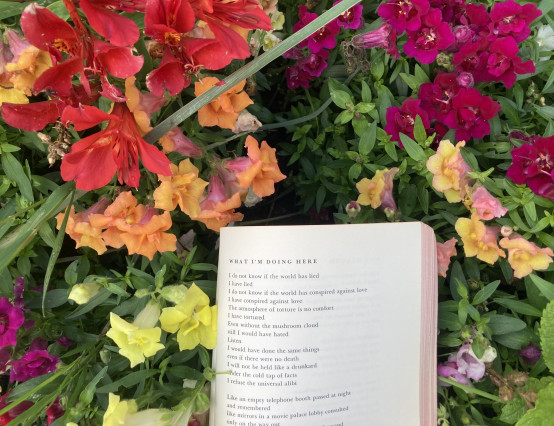Artists Hasti, Pedro Pererira Sarmento and Lishani Ramanayake, staged three separate pieces in collaboration with Artificial Intelligence. They explored what these technologies mean in ethical and creative practice. This exhibition raised many questions that I’ve never thought of before.
The first piece I viewed was titled ‘Ghost Works’ by Hasti. Viewers were handed a guide to show the meaning behind the piece:
“The title … references anthropologist Mary L. Gray’s concept of ‘ghost work’ which describes work performed by a human, but which is believed by a customer to be performed by an automated process. This installation aims to demystify and re-centre the outputs of AI writing models back to their human-produced influences.”
Upon entering a dark room, two screens were before the viewer; we were invited to use the poem machine - with the click of a button, a poem was generated within seconds. To the left a human poet worked at their desk, illuminated by stage lighting. The atmosphere seemed purposefully other-wordly, familiar and distant all at once.
The viewer waited by the desk whilst the poet printed your AI-generated prose beside a piece of their own. We were then invited to sit and read the two poems, side by side on the page.
It was intriguing to see a physical representation of a future where AI and humans work together. Hasti also asks us to consider what would happen if AI were to go on strike in solidarity with humans? How would an AI rest, or what would it read for enjoyment?
Rather than rejecting AI, Ghost Works encourages us to look further into an inevitable future. That we must learn to collaborate with these systems, ensuring that we do not forget the voices of those who make them possible. AI companies must train their models to credit owners of artistic material, amplifying human creation wherever possible. Rather than leaving with a sense of dread, I felt more confident that both artists and consumers in our society can work towards the protection of our right to create. Through strike action, writers, actors and other professionals are already demanding this, paving the way for widespread political activity and inspiring others to consider putting pressure on our governments to legislate against AI’s potential ‘takeover’ of the creative industry.
Sarmento’s piece, A Vague Sense of Belonging, was next. Focusing on the strengths and limitations of AI-generated music, viewers were invited to relax on bean bags and listen to “a long medley with many aesthetic features from the progressive metal genre.” Some parts were composed by the artist and others were composed by AI. The title of the piece is centered around how it feels to not know whether the music has been composed by a human.
As a person who has limited knowledge of composition, I was unsure as to which parts were human-made and which were AI-generated. I made a few guesses, but overall I didn’t have a conclusive answer. It made me feel uneasy; I thought it would be much easier to determine which was which.
Whilst the music played prompts were shown on screens. This encouraged the viewer to look inwards and really consider what Sarmento was asking. For instance, questions such as ‘Does it matter to you if this music is AI generated?’ and ‘Can AI music give you a sense of belonging?’ As technology improves and AI-generated music becomes more widespread, these are questions that will remain crucial and shape us as consumers.
Lishani Ramanayake’s powerful performance was the final stop of AI Encounters. Ramanayake explored the death of Lasantha Wickrematunge, a Sri Lankan journalist and political activist who was murdered for speaking out against the government, through the lens of various AI writing tools.
The audience was surrounded by three large screens, where we were able to read a multitude of prompts focused on the journalist’s death along with the answers each of the AI programmes came up with. The writer provided crucial context that had been missing, exploring how political events may be skewed in favour of particular groups.
The piece was an exploration of how AI writing tools can distort the truth, often not disclosing all known information about particular cases, or even coming up with incorrect information. The viewer was invited to consider who’s truth AI promotes.
Companies are already aware of the biases that exist within their software; since the output of a majority of writing tools is based upon human-made content that already exists. There is a chance that some users of these platforms are not aware of this, taking everything that bots produce as inherent truth.
It is even more alarming then, that Google is now testing an AI called ‘Genesis’ that can write news articles. According to The Guardian, it has already been pitched to incredibly influential media sites such as The New York Times and The Wall Street Journal. Google argues that this programme is not intended to replace journalists and is supposed to ease their workloads by completing fact-checks and analysing data. According to Hibaq Farah, a number of executives for the New York Times who saw the pitch said that the technology could take away from the hard-work and artistic process that journalists put into their work. This is something that Ramanayake’s work brings to light.
It is important to continually question the values and norms of our society and strive for new knowledge and ways of looking at the world. The act of writing itself can provide a platform for exploration, to question what we have been taught, and to push the boundaries of what is possible.
AI Encounters was fantastic in showcasing both the potentialities and limits of Artificial Intelligence when it comes to making art. All three pieces were thought-provoking and beautifully crafted.
I am intrigued to see how all of the artists I have spoken to in this series will continue to excel despite the threat of AI and the corporations that are beginning to adopt it.
Overall, I am left feeling hopeful; human artists will not be replaced without a fight.









0 Comments